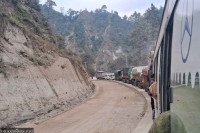Editorial
Licence to plunder
The outrageous announcement erodes years of conservation efforts at the stroke of a pen.
Construction continues to boom in Kathmandu Valley and across the country, with ambitious plans to build smart cities and towns and mega infrastructure. Over the past three decades, the building boom in Nepal has driven illegal and unregulated sand and gravel mining business at the cost of the environment. Excessive excavation of riverbeds and hillsides, environmental experts say, has increased the threat of environmental hazards such as soil erosion, flooding and landslides and groundwater depletion. Besides altering natural water systems and hill slopes, the indiscriminate sand and gravel mining has also killed people, affected livelihoods and made the ecology unstable. But at a time when environmental concerns should have guided government policies, the Oli administration over the weekend announced a plan to extract construction materials and export them.
First things first. It is common knowledge that for a long time now, illegal and unregulated sand and gravel businesses have been allowed to operate freely in the country with protection from politicians, local authorities and the police. Journalists have been attacked and threatened by mining mafias, locals have been silenced, and activists have also been murdered. And although the government has issued a slew of standards for extraction, they remain primarily on paper as mines operate unmonitored and guarded by goons across the country. The consequences are visible for everyone to see and in more detail, in satellite imagery; but rather than alarm the government, which should have introduced sterner implementation of guidelines and launched a massive crackdown on illegal operators, the announcement from the finance minister as part of his budget presentation seeks to overturn the 2014 ban on the export of river and mine-based construction materials to support the interests of a few.
The outrageous announcement erodes years of conservation efforts at the stroke of a pen. It is nothing but a ploy to legalise illegal mines by handing out licences to plunder. Minister Bishnu Prasad Poudel, while announcing the plan, had said that based on an environmental impact assessment, mine-based stones, pebbles and sand can be exported to minimise the trade deficit, but we know very well by now how environmental impact assessments are mere paperwork with no real scientific scrutiny, or the mining wouldn’t have become more rampant after the local-level elections in 2017 which saw more people with ties to the construction and mining business come to power. Besides the conflict of interest of elected officials, conservationists have rightly pointed out how a parallel plan in the new budget offers concession on importing materials required to construct a ropeway for ferrying construction materials from the mining site to the export point reeks of policy corruption.
The demand for sand and gravel will undoubtedly grow as construction picks up pace no sooner than the pandemic situation we are in sees some respite. It is a lucrative business, which makes sand and gravel one of the most valuable contraband. But we cannot wait for an ecological disaster to change our course because the damage to the environment caused by unscientific and unmonitored mining is irreversible. We are mining the materials faster than the river can replenish them. Lest we forget that sand and gravel are non-renewable resources, and the environmental risks are real. In the Chure and Bhawar areas and some parts of the Trishuli and Sunkoshi rivers, haphazard mining of sand has increased soil erosion and flooding, besides affecting the percolation of water and aquatic life. Thus, in the country’s best interest and the environment, the government must immediately drop the myopic and misguided policy, and instead introduce and implement science-guided policies to manage the extraction of riverside materials.




 15.24°C Kathmandu
15.24°C Kathmandu














